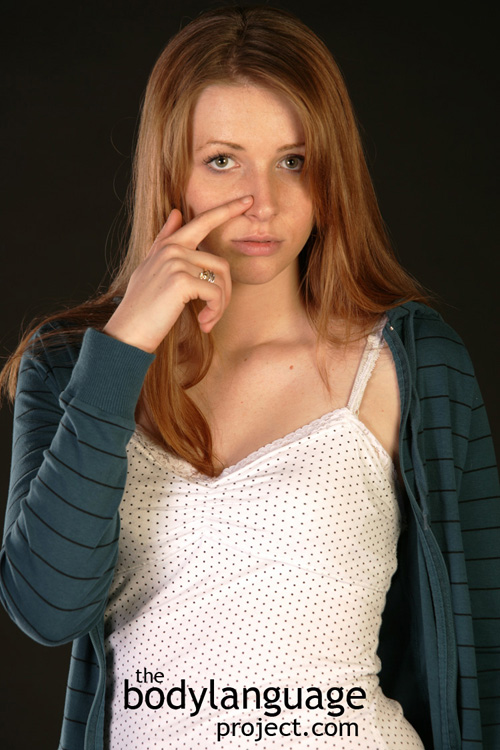Body Language of Shallow Breathing
Synonym(s): Hyperventilating, Shallow Breathing, Panting.
Description: An unusually high and quick rate of respiration.
In One Sentence: Shallow breathing indicates a high level of physical or emotional arousal.
How To Use it: Use shallow breathing to prepare for the flight or fight response. It will help oxygenate the blood in preparation for battle. Hyperventilating is an emergency response signal and if perceived by others will offer medical assistance and emotional support. If this sort of sympathy is desired, then shallow breathing can help garner that sort of attention. Use the signal with care so as not to appear overly dramatic or emotionally unstable.
Context: a) Dating, b) General.
Verbal Translation: “I’m getting so excited I need to consume more and more oxygen in order to get the job done.” “
Variant: See Deep Breathing.
Cue In Action: a) She panted with excitement as their lips met – her lust was obvious b) He was left alone in the woods and didn’t know where he was. The more he moved, the more he panicked. He nearly hyperventilated from fear.
Meaning and/or Motivation: a) When sexually aroused, women (usually) will breath with an excited pace as if hyperventilating. This is thought to function as a way to take in more of the aroma of her partner. b) During a state of elation, panic or fear, people will often take frequent, but shallower breaths.
Cue Cluster: a) Various other sexual cues such as increased proximity, eye contact, removing clothing to be more comfortable, preening, and so forth. b) The winning sports team will often be seen with their arms extended, their heads thrown back and their mouths and eyes opened wide in a state of ecstasy.
Body Language Category: Arousal, Autonomic signal, Courtship display, Indicators of sexual interest (IOsI), Nervous body language, Physiological signals, Physiological signals, Stressful body language, Worry body language.
Resources:
Allen, Ben ; Friedman, Bruce H. Positive emotion reduces dyspnea during slow paced breathing. Psychophysiology. 2012 49(5): 690-696.
Brown, Richard P ; Gerbarg, Patricia L. Sudarshan Kriya yogic breathing in the treatment of stress, anxiety, and depression: part I-neurophysiologic model. Journal of alternative and complementary medicine . 2005. 11(1): 189-201.
Bracha, H. S. (2004). Freeze, flight, fight, fright, faint: Adaptionist perspectives on the acute stress response spectrum. CNS Spectrums, 9, 679–685.
Boiten, Frans A. The effects of emotional behaviour on components of the respiratory cycle. Biological Psychology. 1998. 49(1): 29-51.
Cannon, W. B. (1929). Bodily changes in pain, hunger, fear and rage (2nd ed.). New York: Appleton, Century, Crofts.
Estes, Zachary Estes and Michelle Verges. Freeze or flee? Negative stimuli elicit selective responding. Cognition. 2008. 108(2): 557-565.
Everly, Jr., G. S. & Lating, J. M. (2002). A clinical guide to the treatment of the human stress response (2nd ed.). New York, NY: Kluwer Academic/Plenum Publishers
Ekerholt, Kirsten Bergland. Breathing: a sign of life and a unique area for reflection and action. Astrid Physical therapy. 2008 88(7): 832-40.
Geronemus, Hillary. Breathe Through It. Women’s Health. 2010. 7(3): 068
Hunter, Virginia. Clinical clues in the breathing behaviors of patient and therapist. Clinical Social Work Journal. Summer. 1993 21(2):161-118
Sand-Jecklin, Kari. Patient Anxiety Levels Related to Gynecologic Examinations: Use of the Color Breathwork Relaxation Method. Archives of Psychiatric Nursing. 2008. 22(4): 240-242.
Schmidt, N. B., & Joiner, T., Jr. (2002). Structure of the anxiety sensitivity index: Psychometrics and factor structure in a community sample. Journal of Anxiety Disorders, 16, 33–49.
Schmidt, N. B., Miller, J., Lerew, D. R., Woolaway-Bickel, K., & Fitzpatrick, K. (2002). Imaginal provocation of panic in patients with panic disorder. Behavior Therapy, 33, 149–162.
Schmidt, Norman B. ; Richey, J. Anthony ; Zvolensky, Michael J. ; Maner, Jon K. Exploring human freeze responses to a threat stressor. Journal of Behavior Therapy and Experimental Psychiatry. 2008. 39(3): 292-304.
Tainsky, Al. Calm, cool, collected: a meditation primer. Inside MS, Wntr. 2002. 20(1): 24(4).
Zvolensky, M. J., & Eifert, G. H. (2001). A review of psychological factors/processes affecting anxious responding during voluntary hyperventilation and inhalations of carbon dioxide-enriched air. Clinical Psychology Review, 21, 375–400.



